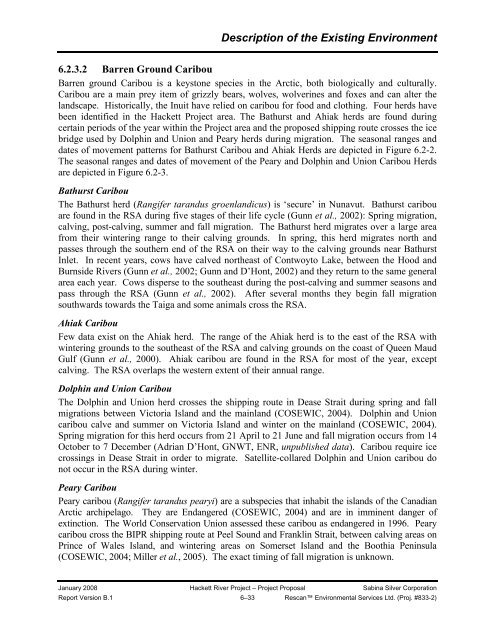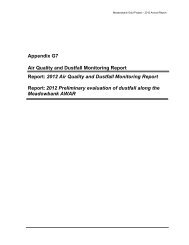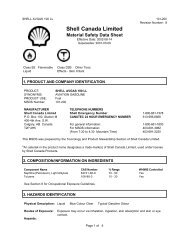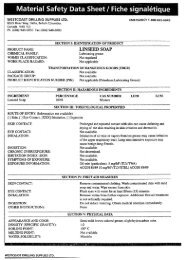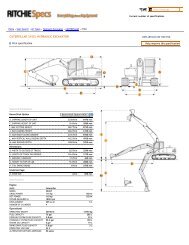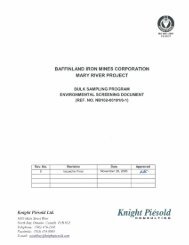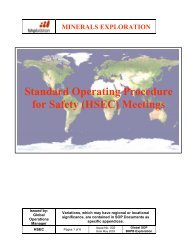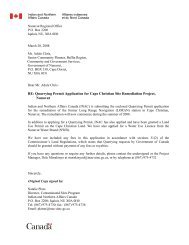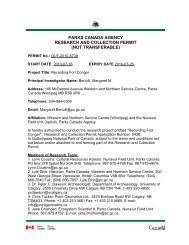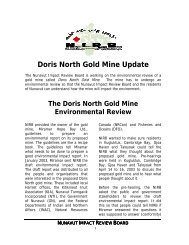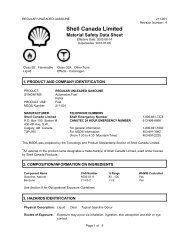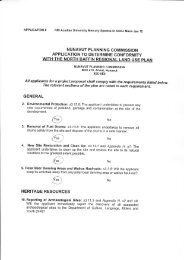080121-08MN006-Sabina Hackett River Project Proposal ... - NIRB
080121-08MN006-Sabina Hackett River Project Proposal ... - NIRB
080121-08MN006-Sabina Hackett River Project Proposal ... - NIRB
You also want an ePaper? Increase the reach of your titles
YUMPU automatically turns print PDFs into web optimized ePapers that Google loves.
Description of the Existing Environment6.2.3.2 Barren Ground CaribouBarren ground Caribou is a keystone species in the Arctic, both biologically and culturally.Caribou are a main prey item of grizzly bears, wolves, wolverines and foxes and can alter thelandscape. Historically, the Inuit have relied on caribou for food and clothing. Four herds havebeen identified in the <strong>Hackett</strong> <strong>Project</strong> area. The Bathurst and Ahiak herds are found duringcertain periods of the year within the <strong>Project</strong> area and the proposed shipping route crosses the icebridge used by Dolphin and Union and Peary herds during migration. The seasonal ranges anddates of movement patterns for Bathurst Caribou and Ahiak Herds are depicted in Figure 6.2-2.The seasonal ranges and dates of movement of the Peary and Dolphin and Union Caribou Herdsare depicted in Figure 6.2-3.Bathurst CaribouThe Bathurst herd (Rangifer tarandus groenlandicus) is ‘secure’ in Nunavut. Bathurst caribouare found in the RSA during five stages of their life cycle (Gunn et al., 2002): Spring migration,calving, post-calving, summer and fall migration. The Bathurst herd migrates over a large areafrom their wintering range to their calving grounds. In spring, this herd migrates north andpasses through the southern end of the RSA on their way to the calving grounds near BathurstInlet. In recent years, cows have calved northeast of Contwoyto Lake, between the Hood andBurnside <strong>River</strong>s (Gunn et al., 2002; Gunn and D’Hont, 2002) and they return to the same generalarea each year. Cows disperse to the southeast during the post-calving and summer seasons andpass through the RSA (Gunn et al., 2002). After several months they begin fall migrationsouthwards towards the Taiga and some animals cross the RSA.Ahiak CaribouFew data exist on the Ahiak herd. The range of the Ahiak herd is to the east of the RSA withwintering grounds to the southeast of the RSA and calving grounds on the coast of Queen MaudGulf (Gunn et al., 2000). Ahiak caribou are found in the RSA for most of the year, exceptcalving. The RSA overlaps the western extent of their annual range.Dolphin and Union CaribouThe Dolphin and Union herd crosses the shipping route in Dease Strait during spring and fallmigrations between Victoria Island and the mainland (COSEWIC, 2004). Dolphin and Unioncaribou calve and summer on Victoria Island and winter on the mainland (COSEWIC, 2004).Spring migration for this herd occurs from 21 April to 21 June and fall migration occurs from 14October to 7 December (Adrian D’Hont, GNWT, ENR, unpublished data). Caribou require icecrossings in Dease Strait in order to migrate. Satellite-collared Dolphin and Union caribou donot occur in the RSA during winter.Peary CaribouPeary caribou (Rangifer tarandus pearyi) are a subspecies that inhabit the islands of the CanadianArctic archipelago. They are Endangered (COSEWIC, 2004) and are in imminent danger ofextinction. The World Conservation Union assessed these caribou as endangered in 1996. Pearycaribou cross the BIPR shipping route at Peel Sound and Franklin Strait, between calving areas onPrince of Wales Island, and wintering areas on Somerset Island and the Boothia Peninsula(COSEWIC, 2004; Miller et al., 2005). The exact timing of fall migration is unknown.January 2008 <strong>Hackett</strong> <strong>River</strong> <strong>Project</strong> – <strong>Project</strong> <strong>Proposal</strong> <strong>Sabina</strong> Silver CorporationReport Version B.1 6–33 Rescan Environmental Services Ltd. (Proj. #833-2)


